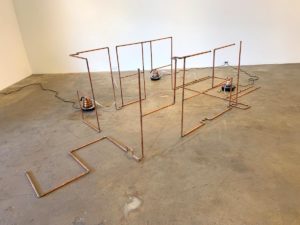
“A flock of sheep near the airport
or a high voltage generator beside the orchard:
these combinations open up my life like a wound, but they also heal it.
That’s why my feelings always come in twos.”
Y. Amichai, poet, translated by C. Block & S. Mitchell
We share the cyclical nature of human experience and memory — the emotional and the intellectual to provide a poetically whole expression of human life. Dualities persist. Austerity and excess, minimalism and obsession, reason and passion, physicality and consciousness interconnect to create the mysterious enigmatic equilibrium of existence.
Existing simultaneously is the state of being between those comparative perspectives. The transition of conversion between waning light and waxing darkness is a metaphor for the human experience of transformation. Dawn and dusk, the blue hour, reference a moment of transitional beauty, the time and space in which anything can happen. The unknown invokes wonderment. I hope to create visual poetry that references this moment of transience.
How does one measure a life and existence? by tasks accomplished, good deeds, repetitions around the sun, material possessions. What family objects are most precious, worthy of carrying and passing on into the future? Is the value due to memory, or its association with monetary worth? How does one define worth?
Using wall relief or book-like format, duality exists within one’s life. Objects of measurement calculate space. The moon cycles continuously through our lives marking time. Dawn and dusk reference moments of transitional and transformative beauty, the time between or the story contained in the pages. The front and backs of the book contrast the simple and austere in conversation with obsessive excess: the passionate heart is equivalent to the brain’s use of reason. The objects reference significant aspects of heritage or moments in life. The cast relief mementos provide immortality, reminding one of the weight of possessions and baggage of memories, as well as the transience and temporality of life versus these precious objects.
What would you take during a natural disaster if you had ten minutes, or from your family home with years to decide? What objects are most precious, worthy of carrying and passing on into the future? Is the value due to memory, or its association with monetary worth? Do you take one item or many?
Oar : Barnacles explores the objects we choose to keep. The blade of the oar contains barnacles of selected objects, referencing significant aspects of our heritage or moments in our lives. The cast relief mementos provide immortality, with the oar acting as the host, to which they are attached and provides them life. Simultaneously, the barnacles, like objects embedded with the past, create a drag on the oar. Instead of being a tool providing forward motion, the concrete barnacled oar reminds one of the weight of possessions and baggage of memories, as well as the transience and temporality of life versus these eternal possessions.